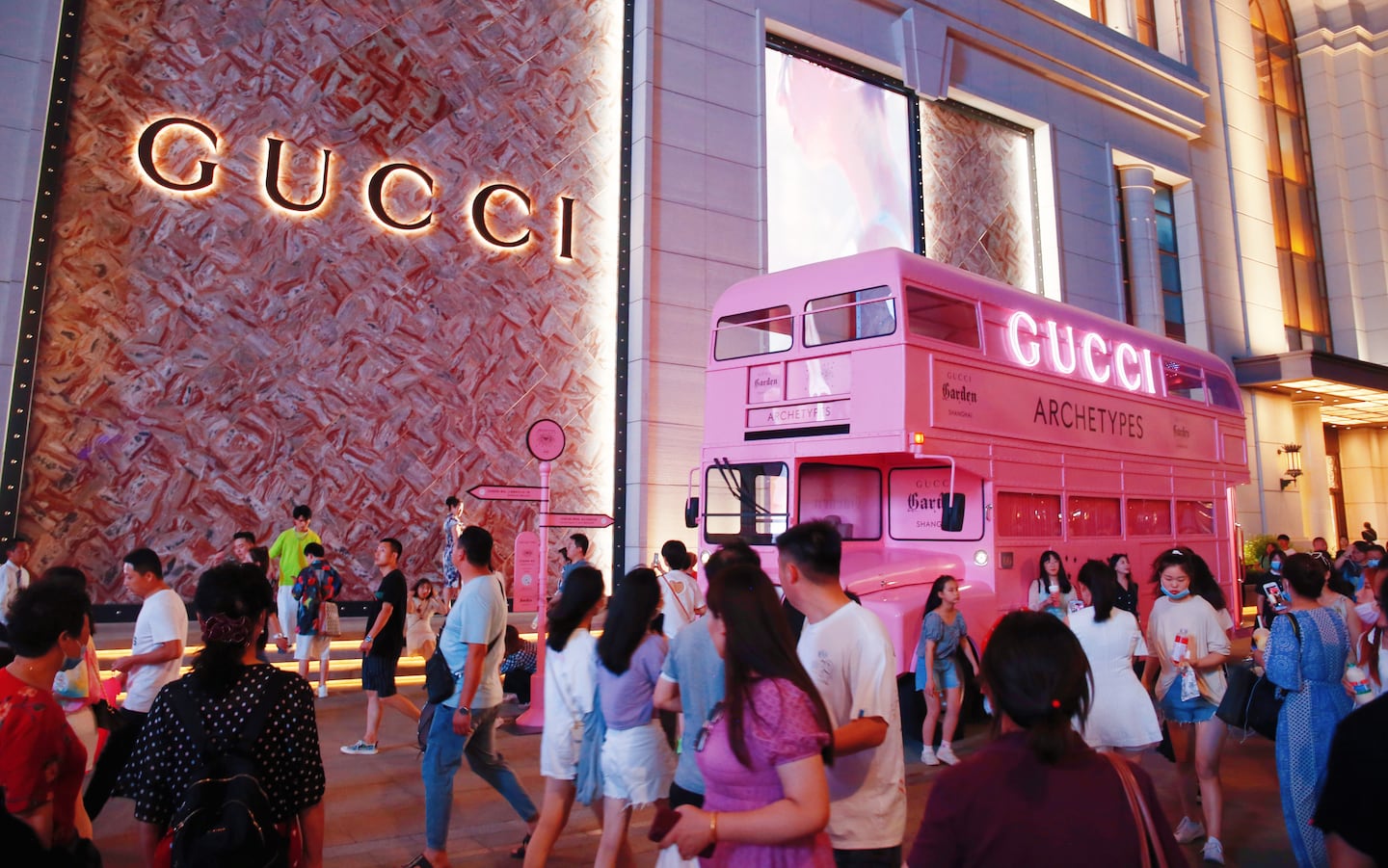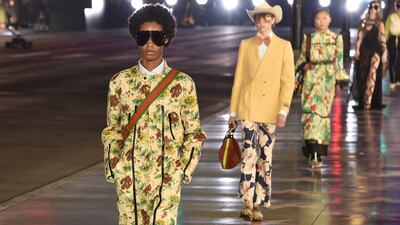
The Business of Fashion
Agenda-setting intelligence, analysis and advice for the global fashion community.

Agenda-setting intelligence, analysis and advice for the global fashion community.

When Paris-based luxury conglomerate Kering reported first-quarter sales last Thursday, the overall picture was rosy: explosive growth at its second-biggest brand, Saint Laurent, helped the group’s revenues climb 21 percent on a comparable basis, 6 percent ahead of estimates.
But slowing growth at flagship label Gucci sparked a sell-off, sending shares down 5.3 percent in Paris trading. The Italian label, which has long accounted for the majority of Kering’s sales and profits, grew 13.4 percent to €2.59 billion ($2.76 billion) compared with analysts’ average estimate of 19 percent.
As recently as February, analysts were lauding Gucci for completing a hefty turnaround since the pandemic. To be sure, the brand had taken longer than rivals like LVMH or Hermès to get sales back above 2019′s pre-Covid levels, but it had also seized opportunities to revamp its product offering and tighten control of distribution during the crisis. “Mission accomplished,” analyst Luca Solca wrote then in a note to clients.
Now, the deceleration at Kering’s key asset has investors worrying again, speculating that the gap between Gucci and fellow “megabrands” like LVMH-flagship Louis Vuitton could continue to widen. (LVMH’s fashion and leather division grew 35 percent in the first quarter).
ADVERTISEMENT
“Is something broken in the Gucci recipe?” one analyst asked after the latest results, a question Kering CFO Jean-Marc Duplaix called “brutal and unfair.” “We have been accustomed to very, very strong growth rates at Gucci, so we need to cope with the new one,” the analyst explained.
“The market is very sensitive to any news about Gucci,” UBS analyst Zuzanna Pusz said. “To say it’s underperforming is a bit harsh. It’s performing in line with the broader sector, whereas the market has an expectation for the bigger brands, the mega-brands, to outperform.”
China Exposure
Rather than anything “broken” in its formula, Kering notably attributed the recent deceleration at Gucci to high exposure to mainland China, where coronavirus lockdowns have returned in major population centres like Shanghai and Shenzhen.
Only 10 percent of Gucci’s stores in mainland China closed during March, but roughly 40 percent of the store network in China was impacted by some form of coronavirus restrictions that impacted store traffic, Duplaix said.
A fast-paced suite of activations to promote Gucci’s Love Parade collection has also been paused due to the lockdowns, he added.
“Gucci is well-penetrated in mainland China, that’s for sure … Even online has been pretty disrupted by the restriction. All the warehouses in Shanghai are closed,” echoed Claire Roblet, Kering’s director of financial communications and market intelligence.
Overall, sales to Chinese clients (domestic and travelling) account for 37 or 38 percent of Gucci sales, compared with a low-30s percentage for most brands according to Citi estimates. Shanghai accounts for one-quarter of Gucci’s Chinese stores — an unusually high exposure for the sector, according to UBS.
ADVERTISEMENT
The brand’s results were stronger elsewhere: in the US, which has been driving growth across the luxury industry in recent quarters, sales grew by 31 percent, while Gucci’s Europe sales jumped a whopping 71 percent — bouncing back sharply from last year’s coronavirus restrictions, as well as offering a sign that local sales are finally on the mend after years of catering to foreign tourists.
Growth Hangover
Still, analysts and retail sources are unsure that Gucci’s slowing growth can be explained solely by the situation in China, which is hurting players across the industry.
“There are valid questions to ask about the brand momentum. If demand was stronger they might not have been hit to the same extent,” said UBS’ Pusz.
Some of the company’s current challenges might amount to a sort of hangover after a multi-year sales rager: from late 2015 to early 2019, Gucci recorded dizzying growth under designer Alessandro Michele and CEO Marco Bizzarri.
Michele’s decadent take on design drove the fashion agenda — interrogating notions of good taste by dialling up the whimsy, romance and even gaudiness inherent to the Gucci brand.
Meanwhile, Gucci’s business pushed like there was no tomorrow. Suppliers across Tuscany were ignited as the brand raced to meet explosive demand for Marmont crossbodies and dragon- or peacock-painted canvas totes. At stores in European shopping hubs like Paris, clienteling was often reduced to crowd control, as visitors would line up to stuff their suitcases with duty-free purchases (much of which might be ultimately resold back home).
The heady time saw Gucci more than double sales and roughly quadruple its operating profits in four years, but also risked saturating the market.
ADVERTISEMENT
“That explosive growth, they didn’t control or contain it,” Citi analyst Thomas Chauvet said. “Has it been growing too big, too quickly for a brand whose products are so visible?”
Elevation Strategy
While the market remains on tenterhooks regarding Gucci’s quarterly performance, the brand has been steadily advancing its strategy, which includes tightening control of distribution while refocusing its core offer to include more higher-priced, iconic products.
“The pullback from wholesale has been radical three years in a row,” Chauvet said. The channel now makes up less than 10 percent, including e-tailers, versus 20 percent of sales prior to Bizzarri and Michele’s tenure.
Kering plans to take that even further this year, exiting online wholesale completely in a bid to eliminate the impact of instantaneous price comparison on its brands.
The pause in China’s daigou trade has also given Gucci an opportunity to clamp down on grey market sales and invest in more direct relationships with clients.

Products are evolving, too. While shows like Gucci’s Love Parade outing in Los Angeles still hammer home Michele’s core message of over-the-top, campy glamour, accessories include a higher share of timeless options, like the relaunched Jackie bag and 1955 Horsebit range.
The brand’s menswear trade has gone in a more classic direction, too, with the brand relying less on logo t-shirts and hoodies in favour of more elevated fare that is still infused with a street-smart vibe. Golf jackets and knitwear stitched with the Gucci monogram are more elevated than merch but still tap into the brand’s logo-fuelled hype. A June presentation in Milan is slated to be Gucci’s first dedicated menswear outing since January 2020.
US Expansion
Amid Gucci’s China-driven slowdown, Kering is leaning into growth in the US market. In a February press conference, chairman François-Henri Pinault said the group was weighing opening more stores in secondary markets including Nashville, Denver and Austin.
Many of those new locations will likely go to the group’s fastest-growing brands like Saint Laurent and Balenciaga rather than Gucci, which already has a robust footprint of 100 stores in the US. But Gucci, too, is set to double down on US retail, with new stores and renovations in its pipeline for cities including Atlanta, Sacramento and Las Vegas.
“Gucci’s US business is still very strong,” retail consultant Robert Burke said. “Kering is seeing good success with their emerging brands, but by no means is Gucci being forgotten.”
Still, results may take time. “Q2 is looking like a challenge: Asia Pacific is set to be weaker than Q1,” Jefferies’ analyst Flavio Cereda wrote. “The Gucci gap [with Louis Vuitton] is a concern.”
Sales at Gucci, which generated more than half of Kering’s revenue in the period, rose about 13 percent on a comparable basis, missing analyst expectations.
This week, Versace and Alexander McQueen named new CEOs, following changes at the top of Chanel, Ferragamo and Burberry. In a sector known for favouring seasoned insiders, non-traditional picks with outside perspectives remain rare.
This week, everyone will be talking about Kering’s first-quarter results and the latest fashion documentary, about the rise and fall of Abercrombie & Fitch.

Robert Williams is Luxury Editor at the Business of Fashion. He is based in Paris and drives BoF’s coverage of the dynamic luxury fashion sector.
The Swiss watch sector’s slide appears to be more pronounced than the wider luxury slowdown, but industry insiders and analysts urge perspective.
The LVMH-linked firm is betting its $545 million stake in the Italian shoemaker will yield the double-digit returns private equity typically seeks.
The Coach owner’s results will provide another opportunity to stick up for its acquisition of rival Capri. And the Met Gala will do its best to ignore the TikTok ban and labour strife at Conde Nast.
The former CFDA president sat down with BoF founder and editor-in-chief Imran Amed to discuss his remarkable life and career and how big business has changed the fashion industry.